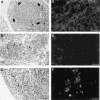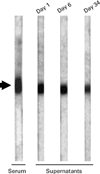In the rheumatoid pannus, anti-filaggrin autoantibodies are produced by local plasma cells and constitute a higher proportion of IgG than in synovial fluid and serum
- PMID: 10691929
- PMCID: PMC1905590
- DOI: 10.1046/j.1365-2249.2000.01171.x
In the rheumatoid pannus, anti-filaggrin autoantibodies are produced by local plasma cells and constitute a higher proportion of IgG than in synovial fluid and serum
Abstract
IgG anti-filaggrin autoantibodies (AFA) are the most specific serological markers of rheumatoid arthritis (RA). They include the so-called 'anti-keratin antibodies' (AKA) and anti-perinuclear factor (APF), and recognize human epidermal filaggrin and other (pro)filaggrin-related proteins of various epithelial tissues. In this study we demonstrate that AFA are produced in rheumatoid synovial joints. In 31 RA patients, AFA levels were assayed at equal IgG concentrations in paired synovial fluids (SF) and sera. AFA titre-like values determined by indirect immunofluorescence and immunoblotting and AFA concentrations determined by ELISA were non-significantly different in serum and SF, clearly indicating that AFA are not concentrated in SF. In contrast, we demonstrated that AFA are enriched in RA synovial membranes, since the ELISA-determined AFA in low ionic-strength extracts of synovial tissue from four RA patients represented a 7.5-fold higher proportion of total IgG than in paired sera. When small synovial tissue explants from RA patients were cultured for a period of 5 weeks, the profile of IgG and AFA released in the culture supernatants was first consistent with passive diffusion of the tissue-infiltrating IgG (including AFA) over the first day of culture, then with a de novo synthesis of IgG and AFA. Therefore, AFA-secreting plasma cells are present in the synovial tissue of RA patients and AFA can represent a significant proportion of the IgG secreted within the rheumatoid pannus.
Figures



References
-
- Sliwinski AJ, Zvaifler NJ. In vivo synthesis of IgG by rheumatoid synovium. J Lab Clin Med. 1970;76:304–10. - PubMed
-
- Loewi G, Darling J, Howard A. Mononuclear cells from inflammatory joint effusions: electron microscopic appearances and immunoglobulin synthesis. J Rheumatol. 1974;1:34–44. - PubMed
-
- Cush JJ, Lipsky PE. Cellular basis for rheumatoid inflammation. Clin Orthop. 1991;265:9–22. - PubMed
Publication types
MeSH terms
Substances
LinkOut - more resources
Full Text Sources
Other Literature Sources
Medical

